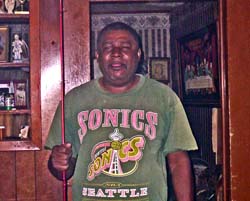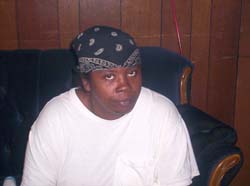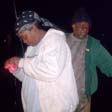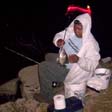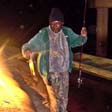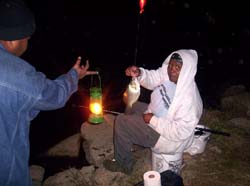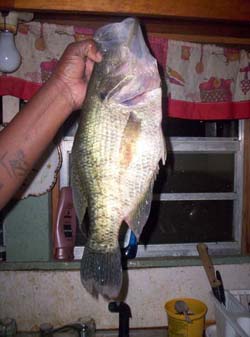Night Fishing In Sabine Parish: A Family Affair
By Rolonda Teal
Perhaps one of the earliest printed references to night fishing can be found in the Bible when the Apostle Simon said, "Master, we have toiled all the night, and have taken nothing; nevertheless at the word I will let down the net" (King James Bible, Luke 5.5). Simon was referring to the traditions of Galilee fishermen who often fished with spears or nets as part of the night time event.
All over the world the tradition of night fishing exists. For example, in Hawaii, night spear fishing is done by the light of kukui-nut torches. Several types of hard woods like kauila, koai`e, and uhiuhi are fashioned into six or seven feet long spears used to procure the prey ("Fishing Methods" 2015). In some Asian societies pitch wood is burned in wire baskets and hung from the side of the sampans to attract the fish. They are then typically caught with nets (Kemp 2010). Perhaps, one of the most unusual instances of night fishing occurs about 250 miles off the coast of Argentina in the Atlantic Ocean. In 2012, a team of NASA researchers composited a map of the night lights on the Earth's surface. In this region of the Atlantic Ocean there appeared to be small human settlements due to the amount of lights. Instead of human settlements, it was just several hundred fishermen trying to catch squid (Carlowicz 2013).
In Louisiana, night fishing exists in some form throughout the state. Although mostly considered a winter sport, it can be done on any cool night. Most people will say that they prefer this method of fishing because the fish bite better in cooler night waters. Others might say, that's the only time they have for fishing since they work during the day. As one participant, Joretta Lloyd, expressed, she night fishes because, "It's fun and very cozy out there around the fire especially when you not catching nothing" (Lloyd 2007). Ronald Shelby echoed her sentiments when he stated, "we go out and really just have fun just catching some of the biggest crappie that you couldn't never catch in the daytime" (Shelby 2007).
I first met Ronald (Ron) Shelby after moving to the small community of Converse, LA. He and his friend Joretta (Joe) Lloyd went fishing almost daily if weather and time permitted. On one occasion, they mentioned that they were going night fishing the next evening. I had not heard of such a thing. My fishing experiences were limited to a few outings with my father to the Gulf of Mexico and to a small pond on my grandmother's land all of which took place in the daylight. While working as an ethnographer with the Five Parishes West Project to document various cultural traditions and the oral folklore of residents of five parishes (Allen, De Soto, Sabine Beauregard, and Vernon) along the Texas state line, I decided to start with the tradition of night fishing.
My first thought after hearing Ron and Joe mention night fishing was how would you see what you are doing in the dark and more importantly how would you see your cork if it went under water. Well, all of my questions and concerns made them excited and they began describing the process of fishing at night. After hearing their explanations, I asked if I could go fishing with them the next night. They agreed that I would meet with them the following day.
The next day they began to prepare for the trip later that evening by going to Wal-Mart to purchase supplies. I tagged along with them. They bought night corks, a small propane bottle and net for a portable Coleman lantern. Since I had never seen a night cork, I was curious how it worked in water. It was explained to me that the cork operated on a battery that was inserted inside and was therefore waterproof. I eagerly awaited a chance to see the cork it in the water later that night.
Once we arrived at Ron's home after leaving Wal-Mart, Ron and Joe began preparing their rods. They put new line on one pole and cut off well-used line from another. Then they replaced a few hooks that were bent and lastly put their night corks on the fishing line. Next, they began to gather firewood from a wooded area near his home. Although Ron lives within the city limits there are still lots next to homes that are dense with trees. Curiosity got the best of me and I asked why firewood was needed. Joe laughed but responded with, "You got to keep warm." Ron explained that you have to build a good fire to keep warm because, "the best time to do that [Crappie fishing] is when it gets cold." On most occasions they bring their own wood but sometimes they gather wood near the fishing area especially if they run out of the wood they brought with them. All that was left to do now was to wait until dusk to go fishing.
Sabine Parish is where both Ron and Joe have lived all their lives. Ron grew-up in Zwolle, while Joe has lived in the Village of Converse located about 15 miles North of Zwolle on Highway 171. Both in their mid-40s, they have had time to become familiar with many of the fishing areas in their vicinity (See Images 1 and 2). Some of their favorite spots along Toledo Bend Reservoir to fish are 3-Bs, Aimwell, La Nana, 1215, and Hot Wells, all of which are separate fishing holes located within a few miles of each other. On occasion they will cross over into Texas and fish at Clarice Creek located on Highway 103.
Ron's hometown of Zwolle as has estimated population of 1, 759 residents. As a culturally blended community primarily comprised of the descendants of Native American, Spanish and French settlers, and African slaves, the 2000 Census data continues to show the diversity of the community with the majority of the population being African Americans (48.95%), followed by Whites (29.96%), then American Indians (15.92%). People of Hispanic or Latino Origin were counted in a separate category. Persons who declared they were not of Hispanic or Latino origin constituted 94.54% of Zwolle's population (U.S. Census Bureau 2010). It is a town known for its annual Tamale Festival, however many people also come to attend the yearly Logger's Festival and the Choctaw-Apache Pow-Wow.
Unlike Zwolle, Converse is smaller with a population of only about 440 people. The cultural demographics of the village is also different in that the majority of residents are Whites (80.00%), followed by American Indians (10.00%), then two or more races (6.14%), while African Americans formed only 3.41% of the population (U.S. Census Bureau 2010). Also unlike Zwolle, there is just one annual event which is the Christmas Parade.
Joretta lives in a sub-community of Converse once known as Babsoline. This was a predominately African American community but over the past 40 years there has been a migration out of the rural area to cities like Houston, Denver, and Seattle, where work opportunities are more abundant. During its heyday, Babsoline was home to at least 25 families who mostly worked as farmers. It was also in this community that the Sabine Normal and Industrial Institute stood. This was one of the first African American schools in the region and children from North Louisiana to East Texas attended the campus. There they were able to live in dormitories that separately housed male and female students. Local lore states that had it not been for the sudden death of the school's founder, Robert Belton, this educational facility would have been the foundation for Grambling State University. Now the community is home to only four African American families.
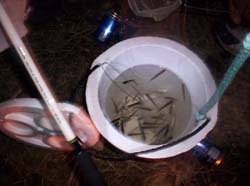
When I arrived at Ron's house the next evening, He and Joe had decided to go to Bayou La Nana, which is a tributary that feeds into Toledo Bend. We loaded the truck with fishing gear, three adults, including myself, Joe's son, Zaikeese, and the family pet Cutis and headed out on our journey. Right outside Zwolle, we stopped to purchase a bucket of live bait known as shiners. Shiners are a silvery fish that can be seen easily by fish in murky waters (See Image 3).
Bayou La Nana is located on Highway 191 and a bridge is used to cross it. It was under the bridge that we began to set-up our equipment. We had our choice since no one else had yet arrived. It was pointed out to me that the advantage of arriving early gave you better seating along the bank. A fire was built, equipment unpacked, night corks placed on lines, and 5-gallon buckets placed on the ground (See Image 4).
The buckets served two functions, they provided a seat while fishing and also held any fish that were caught that night. Each fisherman had their own bucket. When I asked why they didn't share buckets, it was explained that part of the fishing experience was to see who could catch the most fish. It was like a contest. So in order to have an accurate count on the catch, each person used their own bucket (See Image 5).
After fishing for about 10 minutes, Joe caught the first fish for the night and the contest had begun. Ron soon followed with his first fish (See Image 6). They were both fishing for Crappie also known as White Perch. According to Ron, "I think crappie fishing is the best fishing you could do because you can sometimes fish for two hours and catch a 5-gallon bucket." A 5-gallon bucket will hold about 14 fish if they are a good size. To consider the outing a success Joe stated that on a good fishing night she will bring home, "a little more than a 5-gallon bucket" (See Image 7).
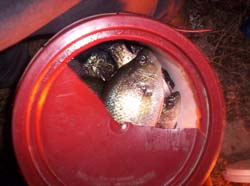
After being there for 40 minutes, more people began to arrive. Two men came together, then a man and his wife, followed soon after by a woman with two children. I stepped back to observe the scene and realized how family-oriented night fishing can be. There was an excitement in the air and mostly everyone asked Ron and Joe how the fish were biting before they sat down to cast their own poles. None of the children actually fished that night; instead, they sat around and ate snacks, played amongst themselves, or walked to fetch things for the adults (See Image 8). Had I accompanied Ron and Joe on a different night I may have witnessed a different sight. "Even the little kids be out there with their little rods" exclaimed Joe. "It can definitely be considered a family outing. Family and friends, everybody."
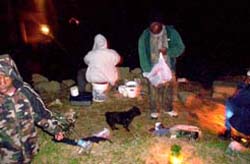
I asked why the children were not fishing and the basic response was that they do sometimes but not tonight. Joe explained that although her mother, Mary Belton, night fished all her life, it had only been, "like 7 or 8 years ago when [she] really got into it." This was after she met Ron. One of the things she liked about it was that, "sometimes it be like 5-6 people and sometimes more than that. We just get together and go," implying that not a lot of preparation is always needed.
There was adequate light under the bridge so that anyone could see if something should come out the water nearby. In the night stillness, it was easy to hear the sounds of Nutrias nearby and especially as they jumped in the water swimming to the opposite shore. Much of the lighting was due to Ron who had brought along two Coleman lanterns and a flashlight. "If I'm fishing up under a bridge or something, . . . I hang my lanterns over the bridge. I have two extra lanterns where I take one and put it on one side [of the bridge]. [If I] put [the second lantern] on the other side and I can light that whole bridge up under there where I'm at" (Shelby 2007).
In addition, light was also created by the campfire. No other light source was present that night. I asked about the effects of a full moon—if it helped with night fishing. Ron slowly replied, "Well, a full moon sometimes hurt ya." This is because fish can see and feed anywhere when the moon is full and shining on the water. Ron recalled that his mother only used flashlights when she went fishing instead of lanterns and night corks. She would shine the flashlight on a regular cork and watch for it go under water, then reel in the fish.
Throughout the evening, a total of about two and a half hours, Ron and Joe continued to catch fish without the use of a net. They decided to call it quits once Joe filled a 5-gallon bucket with fish (See Image 10). Although we were leaving early that was not a typical night. "Lots of people spend almost all night down there, exclaimed Ron. People "go down there just about first dark. They leave sometimes at 4-5 in the morning."
On the way to Ron's house, we reminisced about some of the night's events and told old fishing stories. Once we arrived the only items removed from the bed of the truck were the fishing poles and the 5-gallon buckets full of fish. Ron and Joe put the fish in a large cooler and filled it with ice. They decided they would clean their catch the following morning. As they pulled fish from their buckets, they kept a tally and Joe was pronounced the winner of the fishing contest for the night with a total catch of 22 Crappie while Ron had only caught 18. They took a few out to clean and cook for the night. By 11:30 pm, we were eating fried fish. It sure was tasty.
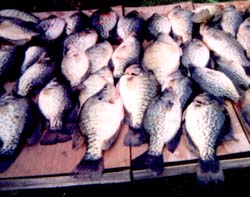
The next day, they laid the fish out on a table outdoors and began cleaning and bagging the fish. They cut some in pieces with tails and fins left intact. Others were filleted and packed in 20-quart freezer bags. I was told that some of the fish would be kept for an upcoming family reunion and a church fish-fry. Not only does the fish help feed Ron and Joe, but also others in the community and relatives returning home. When fishing has been really good, they will pass it out to some of the community elders in Zwolle who can no longer fish for themselves (See image 11).
Toledo Bend Reservoir hosts several Bass Tournaments each year and is considered a premier destination for winning trophies and large cash prizes. For example, on February 16, 2016 at Lake Sam Rayburn Reservoir, anglers won a variety of prizes with First Place fetching a total of $20,000.00 while the 10th place winner took home a total of $1600.00 for a 21.90-pound fish (Binns 2016). Bass fishing on Toledo Bend has proven to be a lucrative tourism industry. Night fishing on the other hand, is not a tourist attraction, but it certainly brings family and friends together who then host their own small competitions. There is never a trophy handed out, nor a cash prize given, but the winner gets bragging rights until the next time they decide to go fishing.
Sources
Binns, J. (2016). Husband-Wife top a record 310 teams & win $20,000 on Toledo Bend with a 28.13 lbs. Retrieved from http://www.fishingworld.com/fishing-and-boating- news/i/34809/t/husband-wife-top-a-record-310-teams-win-20-000-on-toledo-bend-with- 28.13-lbs
Carlowicz, M. (2013). Something Fishy in the Atlantic Night. Retrieved from http://earthobservatory.nasa.gov/Features/Malvinas/
Fishing Methods. (2016). Info Grafik. Retrieved from http://www.hawaiihistory.org/index.cfm?fuseaction=ig.page&PageID=380
Kemp, Jonathan. 2010. Chinese Start Monterey Fishing Industry. Monterey County Historical Society. Retrieved from http://mchsmuseum.com/chinesefishing.html March 2, 2016.
King James Bible. Thomas Nelson Bibles. A Division of Thomas Nelson, Inc.
Lloyd, Joretta. 2007. Personal Communication. February 1.
Office. U.S. Census Bureau. (2010). (Population by race). Retrieved from http://censusviewer.com/city/LA/Zwolle
Office. U.S. Census Bureau. (2010). (Population by race). Retrieved from http://censusviewer.com/city/LA/Converse.
Shelby, Ronald. 2007. Personal communication. January 31.


